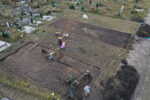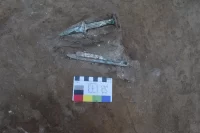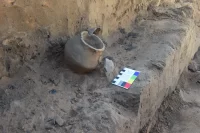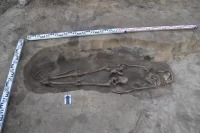 Workers expanding a modern cemetery on the outskirts of Krasnoyarsk, Siberia, discovered the mound they were leveling was a pre-historc kurgan of a Scythian-type culture from the first millennium B.C. The burial mound met the business end of the cemetery’s bulldozer in 2018, but was not archaeologically excavated until 2021. Excavations continued this summer, revealing dozens of human remains in group and individual burials.
Workers expanding a modern cemetery on the outskirts of Krasnoyarsk, Siberia, discovered the mound they were leveling was a pre-historc kurgan of a Scythian-type culture from the first millennium B.C. The burial mound met the business end of the cemetery’s bulldozer in 2018, but was not archaeologically excavated until 2021. Excavations continued this summer, revealing dozens of human remains in group and individual burials.
While ancient kurgans were known to have existed in the Krasnoyarsk area, most of them were destroyed during the city’s rapid development in the 20th century. This one was documented in old pictures and in a survey from early last century, recorded as a large mound 100 feet in diameter. Its existence was obscured and forgotten as the city expanded, only returning to public note after it was bulldozed, ironically. It is the first kurgan to be excavated in Krasnoyarsk in 65 years.
Luckily, the tomb beneath survived the bulldozing and turned out to contain dozens of bodies in a large rectangular pit, that had been walled with timber and carpeted in birch bark.
The upper part of the tomb was damaged by the works but parallels with tombs from the era suggest it once had a wooden roof, thus creating what is known as a box tomb, [Siberian Federal University archaeologist Dmitry] Vinogradov explained.
Preliminary counts suggest the tomb may have contained as many as 50 people buried with grave goods ranging from beads to bronze plaques, miniature symbolic bronze daggers and battle axes, as well as knives, mirrors, and needles; and ceramic vessels that had contained foods: all items the deceased might have “needed” in the afterlife, Vinogradov speculates.
One plaque depicted a stag, a popular motif in Siberian Scythian animal art.
 Archaeologists believe the burial mound belongs to the Tagar culture that inhabited southern Siberia between the 8th and 2nd centuries B.C. Genetic analysis suggests they were related to the Bronze Age Scythian cultures of the Eurasian steppe, likely descended from Scythian groups who had migrated east from Western Europe. The Tagar culture shares many commonalities with Scythian cultures to the west, including iconographic motifs like art with stylized depictions of animals including stags with elaborate antlers like the one on the bronze plaque discovered in the kurgan.
Archaeologists believe the burial mound belongs to the Tagar culture that inhabited southern Siberia between the 8th and 2nd centuries B.C. Genetic analysis suggests they were related to the Bronze Age Scythian cultures of the Eurasian steppe, likely descended from Scythian groups who had migrated east from Western Europe. The Tagar culture shares many commonalities with Scythian cultures to the west, including iconographic motifs like art with stylized depictions of animals including stags with elaborate antlers like the one on the bronze plaque discovered in the kurgan.
 The earliest Tagar burials typically contain stone cist graves. Funerary practice shifted in later centuries to wooden chamber tombs containing the remains of multiple individuals, added over the course of years, perhaps generations. Once full, the wooden grave and all the remains inside of was sealed and set ablaze. When the fire went out, the tomb was covered in soil, thus forming the mound. The soil of the recently-excavated wooden chamber tomb bears the tell-tale signs of a high-temperature conflagration.
The earliest Tagar burials typically contain stone cist graves. Funerary practice shifted in later centuries to wooden chamber tombs containing the remains of multiple individuals, added over the course of years, perhaps generations. Once full, the wooden grave and all the remains inside of was sealed and set ablaze. When the fire went out, the tomb was covered in soil, thus forming the mound. The soil of the recently-excavated wooden chamber tomb bears the tell-tale signs of a high-temperature conflagration.
 The kurgan still served a funerary purpose even after the fire. Archaeologists unearthed ten pit burials around the perimeter of the mound. The people laid to rest in the pits were buried in different positions — supine, prone, side — and were sometimes alone in a grave, sometimes buried with one or more others. The graves contained the remains of children, adults, men and women, and only a handful of grave goods found in three of the pits.
The kurgan still served a funerary purpose even after the fire. Archaeologists unearthed ten pit burials around the perimeter of the mound. The people laid to rest in the pits were buried in different positions — supine, prone, side — and were sometimes alone in a grave, sometimes buried with one or more others. The graves contained the remains of children, adults, men and women, and only a handful of grave goods found in three of the pits.
This style of burial and its grave goods dates the kurgan to 400-100 B.C. If it closer to the end of that range, it might be more correctly attributed to the transitional Tesinian culture that emerged in the area in the 2nd century B.C.